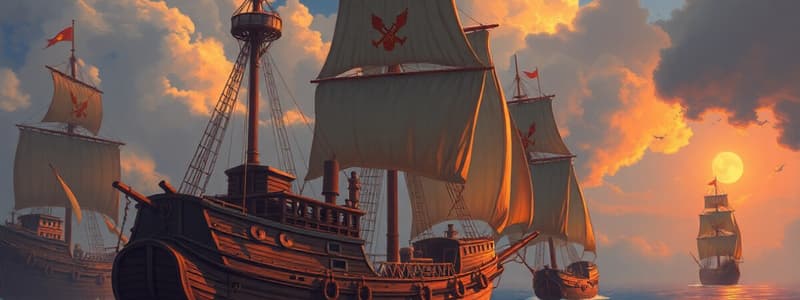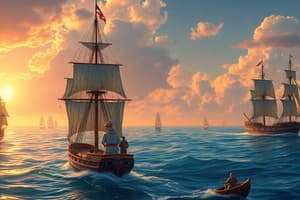Podcast
Questions and Answers
What was a significant characteristic of the Indian Ocean slave trade compared to the Atlantic slave trade?
What was a significant characteristic of the Indian Ocean slave trade compared to the Atlantic slave trade?
- Slaves in the Indian Ocean often had opportunities to form communities. (correct)
- Slaves in the Indian Ocean had no rights or freedoms.
- Slaves in the Indian Ocean were mostly transported to the Americas.
- Slaves in the Indian Ocean primarily worked in agriculture.
Which economic system played a key role in the sustenance of the colonies established by European powers?
Which economic system played a key role in the sustenance of the colonies established by European powers?
- Mercantilism (correct)
- Capitalism
- Socialism
- Feudalism
Which of the following groups was a result of the mixing of ethnicities during colonial times?
Which of the following groups was a result of the mixing of ethnicities during colonial times?
- Oligarchs
- Merchants
- Sailors
- Mestizos (correct)
What factor significantly differentiated the roles of slaves in Islamic communities from those in other areas?
What factor significantly differentiated the roles of slaves in Islamic communities from those in other areas?
Which empire had a notable impact on the African states during the height of the slave trade?
Which empire had a notable impact on the African states during the height of the slave trade?
What was a significant outcome of the Treaty of Tordesillas in 1494?
What was a significant outcome of the Treaty of Tordesillas in 1494?
What role did diseases play in the collapse of the Aztec and Inca Empires?
What role did diseases play in the collapse of the Aztec and Inca Empires?
Which event marked the end of the Inca Empire in 1572?
Which event marked the end of the Inca Empire in 1572?
What was significant about the establishment of St. Augustine by Spain in 1565?
What was significant about the establishment of St. Augustine by Spain in 1565?
How did the arrival of British settlers affect the Iroquois in the Northeast?
How did the arrival of British settlers affect the Iroquois in the Northeast?
What was one of the primary motivations for the Spanish conquest of the Aztec Empire?
What was one of the primary motivations for the Spanish conquest of the Aztec Empire?
Which statement reflects the economic impact of Spanish colonization on indigenous populations?
Which statement reflects the economic impact of Spanish colonization on indigenous populations?
Which geographic area did Spain maintain claim to after the Treaty of Tordesillas?
Which geographic area did Spain maintain claim to after the Treaty of Tordesillas?
What was the primary outcome of the Great Peace of Montreal signed in 1701?
What was the primary outcome of the Great Peace of Montreal signed in 1701?
How did the Portuguese approach trade in the Indian Ocean compared to traditional merchants?
How did the Portuguese approach trade in the Indian Ocean compared to traditional merchants?
What factor contributed to the disruption of the Indian Ocean trading networks by Europeans?
What factor contributed to the disruption of the Indian Ocean trading networks by Europeans?
In which conflict did Britain drive France out of both India and Canada?
In which conflict did Britain drive France out of both India and Canada?
What economic system was primarily utilized by merchants in the Indian Ocean before European dominance?
What economic system was primarily utilized by merchants in the Indian Ocean before European dominance?
What was a significant disadvantage for the native populations in the Indian Ocean due to Portuguese trade practices?
What was a significant disadvantage for the native populations in the Indian Ocean due to Portuguese trade practices?
Which goods were part of the lucrative trade routes that the Portuguese controlled in the Indian Ocean?
Which goods were part of the lucrative trade routes that the Portuguese controlled in the Indian Ocean?
What was the role of the Hudson's Bay Company in colonial North America around 1650?
What was the role of the Hudson's Bay Company in colonial North America around 1650?
Flashcards
Indian Ocean Slave Trade
Indian Ocean Slave Trade
The historical transportation of enslaved people from eastern Africa to places like northern Africa, the Middle East, and India, often via ocean routes.
Chattel Slavery
Chattel Slavery
A system where enslaved people are considered property and are treated as commodities.
Asante Empire
Asante Empire
A powerful West African empire known for its strong political and military organization.
Mercantilism
Mercantilism
Signup and view all the flashcards
Conquistadores
Conquistadores
Signup and view all the flashcards
Great Peace of Montreal
Great Peace of Montreal
Signup and view all the flashcards
French and Indian War
French and Indian War
Signup and view all the flashcards
Indian Ocean Trade Networks
Indian Ocean Trade Networks
Signup and view all the flashcards
European Naval Superiority
European Naval Superiority
Signup and view all the flashcards
Portuguese in Indian Ocean
Portuguese in Indian Ocean
Signup and view all the flashcards
Traditional Trading Ties
Traditional Trading Ties
Signup and view all the flashcards
Columbus's Impact on Profit Seeking
Columbus's Impact on Profit Seeking
Signup and view all the flashcards
Indian Ocean Trade Continuity
Indian Ocean Trade Continuity
Signup and view all the flashcards
Aztec Empire
Aztec Empire
Signup and view all the flashcards
Inca Empire
Inca Empire
Signup and view all the flashcards
Treaty of Tordesillas
Treaty of Tordesillas
Signup and view all the flashcards
Spanish Conquest of Mexico
Spanish Conquest of Mexico
Signup and view all the flashcards
Spanish Conquest of the Inca
Spanish Conquest of the Inca
Signup and view all the flashcards
European diseases in Americas
European diseases in Americas
Signup and view all the flashcards
St. Augustine
St. Augustine
Signup and view all the flashcards
North American claims
North American claims
Signup and view all the flashcards
Study Notes
Maritime Empires
- European nations established maritime empires in Asia, Africa, and the Americas between 1450-1750, driven by political, religious, and economic rivalries.
- Asian trade involved exchanging silver and gold for luxury items like silk and spices.
- Colonial economies in the Americas relied heavily on agriculture, using existing and new labor systems.
- Indentured servitude: Servants contracted for a set period of years in exchange for passage.
- Chattel slavery: Individuals were treated as property, bought and sold.
- The growth of plantation economies increased demand for slaves in the Americas, causing significant demographic, social, and cultural changes.
State-Building and Empire Expansion
- European state explorations formed the basis of maritime empires, claiming lands and establishing an empire.
Trading Posts in Africa and Asia
- Portuguese explorers and traders established trading posts in Africa and Asia to engage in the lucrative trade with local rulers.
- Some African states grew wealthy by selling enslaved people to Europeans.
- African artisans incorporated European images into their carvings.
- The Portuguese invaded Swahili city-states, causing significant decline.
- Japan sharply restricted its trading networks, later isolating itself from the outside world.
- The Ming Dynasty in China limited outside influence and restricted trade.
European Rivalries on Five Continents
- European rivalries, driven by political, economic, and religious motives, shaped empire expansions.
- The British East India Company had commercial relationships with the Mughal Empire in the 17th century.
- Portugal controlled trading posts and territories.
- France controlled Pondicherry.
- Britain's victory in the Seven Years' War (1763) drove France out of India.
- British trading posts in India were originally focused on trade, but later expanded its political power.
Europeans in the Americas
- The Aztec and Inca Empires, boasting large populations, collapsed following European arrival due to disease and conquest by Spanish forces.
- Cortés conquered the Aztec Empire and established the colony of New Spain.
- Pizarro conquered the Inca Empire.
- The Treaty of Tordesillas (1494) divided the Americas between Spain and Portugal.
- Spain claimed most of the Americas, while Portugal claimed Brazil.
Continuity and Change in Economic Systems
- European trade disruptions, while impacting the Indian Ocean trading networks, generally coexisted with existing networks.
- Mercantilism: Economic practices emphasized government control and maximization of exports.
- The Portuguese, through military strength, controlled Indian Ocean trade routes including parts of the Arabian Sea and the east coast of Africa in the Indian Ocean.
- Spain established the encomienda system forcing indigenous peoples into labor in exchange for food.
- Spanish conquistadors gained land in both Mesoamerica and South America due to the existing power structures in those native societies.
- The silver trade from Mexico and Peru propelled the Spanish economy but caused significant population decline in those regions.
Continuity and Change in Labor Systems
- Europe relied on multiple labor systems, each suited to specific circumstances and regional requirements.
- Laborers included enslaved people, indentured servants, serfs, and free peasants.
Why Africans?
- Europeans turned to enslaved Africans for labor in the Americas due to disease decimating the indigenous populations.
- The Atlantic slave trade devastated African societies.
- Enslaved Africans were traded for European goods.
The Horrors of the Journey
- The "Middle Passage" was the perilous journey across the Atlantic by enslaved Africans.
- Enslaved people experienced horrific conditions.
- Millions of people died during the journey, or immediately after arrival in the Americas.
Demographic, Social, and Cultural Changes
- Large-scale importation of enslaved Africans caused profound demographic, social, and cultural changes in the Americas and various European regions.
- This exchange led to new social classes and mixed-race populations.
- Slave trade significantly impacted family structures and relations.
Studying That Suits You
Use AI to generate personalized quizzes and flashcards to suit your learning preferences.




